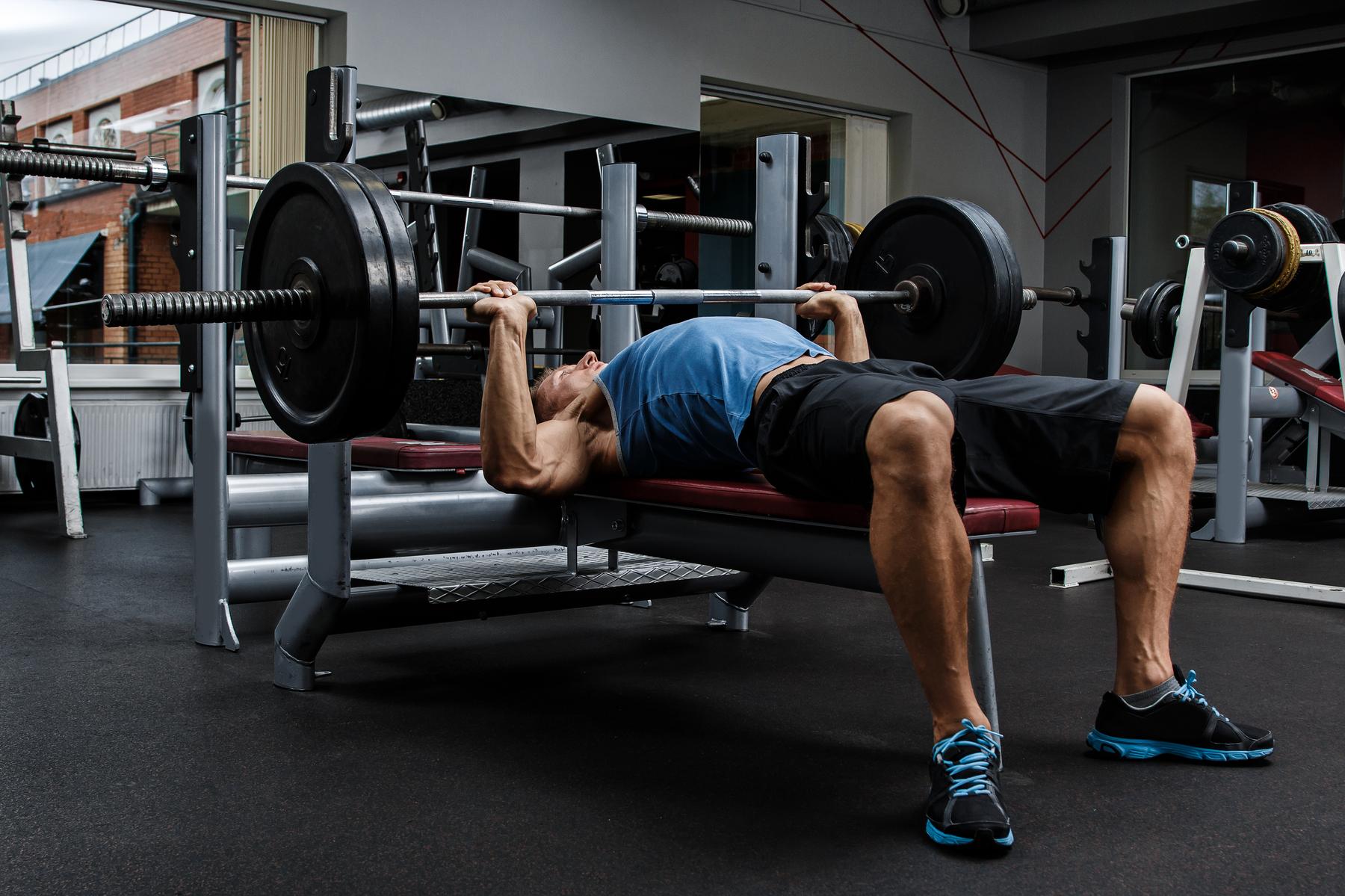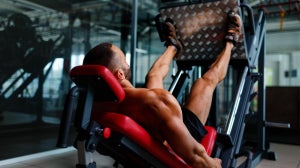
The bench press is a key exercise for anyone who is serious about gaining muscle, strength and size. As well as being one of the three power lifts (alongside the squat and deadlift), it is also one of the most effective chest and triceps builders that you can do due to it hitting the most muscles in one movement compared to any other chest exercise.
However, just like the squat and deadlift, the bench press is often performed inefficiently or incorrectly. Here’s a brief guide to the bench press, which muscles it works, how to set up correctly and common faults and fixes.
How to set up a bench press
Although it looks relatively simple, there’s actually a proper way of setting up for a bench press that will both make you stronger and reduce your risk of injury.
To begin, ensure that you have set the bar at the right height. Although this is subjective, and there are no hard and fast rules on this, it should be low enough that you can reach it without having to stretch, but not so low that you have already done a rep just un-racking the bar!
Bench press technique
The Bench
- Sit at the end of the bench and lie back so that the bar is behind your head.
- Place your hands on the bar, pull your shoulder blades back into the bench, and then slide yourself up to the bench until your eyes are directly under the bar. This way, your shoulder blades stay pinned back and low, which gives your upper body greater stability.
- Ensure that your feet are flat on the floor. This provides your body with a stable base with which to push from, enabling you to move more weight. Occasionally, you may find that the bench you are using is a little too high for you to get your feet flat on the floor. If this is the case, try to place your feet on the bench supports.
- Alternatively, grab yourself a step and place it at the end of the bench for you to put your feet on. Resist the temptation to lift your feet off the ground when benching – this will only compromise your stability, therefore making you weaker and more likely to injure yourself.
Grip
- To take your grip, utilise the reference points on the bar. Olympic bars are divided into smooth and gripped sections – for the optimal grip width, place the tip of your outstretched thumb where the main grip begins (the two gripped sections either side of the middle of the bar).
- Proceed to wrap your thumb around the bar and point your knuckles to the ceiling.
- Try not to let the bar sit in your palm – this can lead to the wrists being excessively bent backwards and cause wrist pain further down the line.
- Allow the bar to sit with the pad of the thumb. When done correctly, your knuckles will point straight up and your wrists will be totally straight.
- Avoid the false grip, where the thumb sits underneath the bar, as you are more likely to injure your wrists this way.
The bench press
- After taking your grip, gently squeeze and apply pressure to the bar as if you are trying to snap a twig. The tension should be such that you feel a tension in your shoulders, but not so much that you are about to pass out from elevated blood pressure!
- One of their key functions is to keep the upper arms stable in the shoulder joint. Activating them by ‘breaking the bar’ means that they provide the shoulder with additional stability during the bench press.
- The physical effect that this will have is that your elbows will be much more tucked into your body, as opposed to flaring out to the side. Whilst this may feel strange at first, it is absolutely vital for avoiding shoulder injuries (incorrect bench pressing is one of the most common causes of shoulder injuries) and for an ultimately stronger bench press.
- Now you know how to set up and execute a perfect bench press, don’t mess it up by losing all of the tension you’ve created as soon as you un-rack the bar – keep your shoulder pinned into the bench and keep bending the bar!
- When done correctly, you will lower the bar to your lower chest/sternum, keeping your elbows tucked in at around a 45-degree angle to your body.
- Tap your chest with the bar, pause, then extend your arms and squeeze your pecs at the top.Be careful not to lock-out your elbow – you should extend your arms as far as you can without locking them into place.
- Do not round the shoulders forward at the top of the lift, keep them pinned back! You should feel as though you are puffing your chest out, and your back will feel slightly arched.
Tips
- Don’t bounce the bar off your chest. It is important to keep the tension throughout the movement. Whilst it may mean you lift slightly less weight than you ultimately could, it will result in greater size and strength gains due to a higher recruitment of muscle fibres.
- As for breathing, take in a big breath at the top, hold it as you lower the bar, and release as you push the bar up. Don’t forget to get your breath back in between reps!
Which muscles does the bench press target?
Pectorals
The bench press is first and foremost a chest exercise. The primary muscle worked is the pectoralis major (the pecs). The main function of the pectoralis major is to control the lateral and vertical movement of the arm. It is connected to the upper arm through the pectoralis tendon, which stretches across the front of the shoulder.
Triceps and Deltoids
In addition to the pecs, the bench press also recruits two other muscle groups to assist in the movement, referred to as synergists. These synergists are the triceps and the deltoids. In a bench press, both the shoulder joint and the elbow joint must extend in unison to facilitate the movement. The triceps control extension of the arm at the elbow by contracting (the ‘push’ phase of the bench press) and allow the elbow to bend by relaxing (the ‘lowering’ phase). At the same time, the anterior deltoids contract with the pecs to extend the arm vertically at the shoulder joint during the bench press.
All of these joints and muscles working together to complete a single movement mean that the bench press is a compound exercise – an exercise that requires movement at more than one joint. The result is a greater activation of muscle fibres and a greater anabolic response, which means greater size and strength!
Bench press: Common mistakes and how to fix them
1. Flared Elbows
Bench press rookies and seasoned gym-goers are equally as likely to be making this mistake.I earlier outlined the importance of ‘breaking the bar’ to engage the musculature of the shoulder. The purpose of this is to provide the shoulder with greater stability and to make the joint stronger.
When you flare your elbows out during a bench press, the pectoral tendon (which runs across the front of the shoulder and attaches to the upper arm) is stretched further than it has to be. When you add a heavy load, an excessively stretched tendon is far more likely to rupture or tear because it’s structurally weaker when overstretched.
Flared elbows are one of the most common causes of shoulder pain when bench pressing, and if left unchecked shoulder pain can cause all kinds of havoc – pretty much every compound upper body exercise requires movement at the shoulder, so an injury to this joint can seriously impact your training.
The Fix:
At setup and throughout the lift, keep your shoulders engaged and your elbows tucked in by applying tension to the bar as though you’re trying to bend it. When done correctly, your upper arms should be at roughly a 45-degree angle to your body during the lift. It will feel strange at first, and you may have to drop the weight a little to get used to it, but your shoulders will thank you!
2. Poor Range Of Motion
Usually the result of lifting too much weight as opposed to anything being wrong with technique, poor range of motion (ROM) is detrimental for a number of reasons. When done correctly, the bar should make contact with or be no more than an inch above the lower chest at the bottom of the movement. This allows an optimal contraction of the pectoral muscles, and therefore greater muscle activation.
Beginning the concentric (press) portion of the movement any earlier than this cheats you out of a full muscle contraction, which means less muscle growth and slower strength development over time. It also means that your triceps will be bearing the brunt of the load as opposed to your chest, which defeats the objective of a bench press – remember, although your triceps get a good workout from bench pressing, it is primarily a chest exercise!
The Fix:
If you consistently find you’re unable to lower the weight to your chest, there are two possible causes: you have a pre-existing shoulder injury that limits your range of motion (in which case, you shouldn’t be bench pressing anyway) or the weight you are lifting is simply too heavy for you.
Seeing as the latter is the cause of 99.9% of ROM issues, it’s a pretty good bet that simply dropping the weight down will greatly improve your bench press ROM. Always remember, the weight you lift isn’t important – time under tension and a full range of motion have been consistently proven to be the key factors determining muscle growth. Leave your ego at the door, drop down the weights and perfect your form before you load up the bar again!
3. Lifting Your Body Too Far Off The Bench
This area is somewhat contentious. Talk to a powerlifter, and they will tell you that by arching your back and lifting your chest closer to the bar, you are reducing the distance that the bar has to travel and you can therefore lift more weight, which is what’s most important to a powerlifter. On the other hand, a bodybuilder would tell you to keep your back flat and use as great a ROM as possible in order to isolate the pecs and stimulate the most amount of muscle growth possible, which is what’s most important to a bodybuilder.
Neither approach is wrong, and depending on your goals, you can do either/or. What is incorrect, however, is excessively lifting your body off of the bench during a bench press. By removing points of contact with the bench, you make the entire structure weaker, and therefore you become weaker. So what is excessive? In general, a small arch in the back is fine. If you find that in addition to this arch, your backside is lifting off the bench and you are starting to incorporate a hybrid glute bridge into each rep, you are lifting your body off too far.
The Fix:
The reason for excessively lifting your body off the bench ties in directly with the previous fault: you are, in all likelihood, trying to lift too much weight. If you’re unable to achieve a full range of motion in any exercise due to excessive weight, the body will often make compensations to give you the illusion of full ROM.
In the case of the bench press, you will subconsciously move your body closer to the bar as you lower it, giving the appearance of full ROM. So once again, take weight off the bar and focus on your technique. Revisit all of the setup points from Part One: pull your shoulders back into the bench and keep your feet flat on the floor. This will make your body more stable and therefore less likely to rise up from the bench.
4. ‘Broken’ Wrists & False-Grips
Now I don’t mean literally broken wrists (although chronic misuse of the wrists when bench pressing will certainly increase the likelihood of this). When I say broken, I mean wrists that are bent back on themselves when bench pressing, as opposed to straight wrists that are un-bent.
Sitting the bar in your palms forces the hand to bend backwards, which puts excessive strain on the wrists under heavy loads and can lead to chronic wrist pain. If you already suffer from a repetitive strain related injury in the wrists, it can further compound the issue.
The Fix:
Rather than holding the bar in your palms, allow it to sit in the pad of your thumb and point your knuckles to the ceiling – try to imagine there is a straight line going downwards through the bar directly down your forearm. Always wrap your thumb around the bar and avoid the false grip (when the thumb is tucked underneath the bar), as it’s almost impossible not to break the wrists back when using this grip.
Take Home Message
So there you have it, some of the most common bench press faults and their fixes. If you are guilty of any of these faults, addressing them quickly and easily will do wonders for your bench press, as well as making you stronger and more injury-proof.
Our articles should be used for informational and educational purposes only and are not intended to be taken as medical advice. If you're concerned, consult a health professional before taking dietary supplements or introducing any major changes to your diet.









